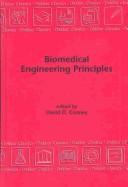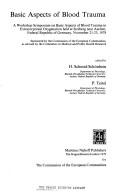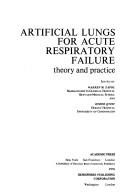| Listing 1 - 10 of 13 | << page >> |
Sort by
|
Book
Abstract | Keywords | Export | Availability | Bookmark
 Loading...
Loading...Choose an application
- Reference Manager
- EndNote
- RefWorks (Direct export to RefWorks)
Book
ISBN: 0444414533 Year: 1976 Publisher: Amsterdam : Elsevier,
Abstract | Keywords | Export | Availability | Bookmark
 Loading...
Loading...Choose an application
- Reference Manager
- EndNote
- RefWorks (Direct export to RefWorks)
Book
ISBN: 0333223136 Year: 1977 Publisher: London Macmillan
Abstract | Keywords | Export | Availability | Bookmark
 Loading...
Loading...Choose an application
- Reference Manager
- EndNote
- RefWorks (Direct export to RefWorks)
Adsorption --- Renal Dialysis --- Kidneys, Artificial --- Liver --- Oxygenators, Membrane --- Poisoning

ISBN: 0824763475 Year: 1976 Publisher: New York (N.Y.): Dekker
Abstract | Keywords | Export | Availability | Bookmark
 Loading...
Loading...Choose an application
- Reference Manager
- EndNote
- RefWorks (Direct export to RefWorks)
Artificial kidney --- Biological transport --- Biomedical engineering --- Oxygenators --- Mathematical models
Book
ISBN: 1789239249 1789239230 Year: 2019 Publisher: London, England : IntechOpen,
Abstract | Keywords | Export | Availability | Bookmark
 Loading...
Loading...Choose an application
- Reference Manager
- EndNote
- RefWorks (Direct export to RefWorks)

ISBN: 9024722799 9400993374 9789024722792 Year: 1979 Volume: 6467 EN Publisher: The Hague: Nijhoff,
Abstract | Keywords | Export | Availability | Bookmark
 Loading...
Loading...Choose an application
- Reference Manager
- EndNote
- RefWorks (Direct export to RefWorks)
Blood physiology. Circulatory physiology --- Blood --- Oxygenators --- Blood coagulation disorders --- Hemolysis and hemolysins --- Circulation, Artificial --- Complications --- Congresses --- Blood - Circulation, Artificial - Complications - Congresses --- Oxygenators - Congresses --- Blood coagulation disorders - Congresses --- Hemolysis and hemolysins - Congresses
Book
ISBN: 9535125532 9535172999 9535125524 9789535172994 9789535125532 Year: 2016 Publisher: IntechOpen
Abstract | Keywords | Export | Availability | Bookmark
 Loading...
Loading...Choose an application
- Reference Manager
- EndNote
- RefWorks (Direct export to RefWorks)
Extracorporeal membrane oxygenation (ECMO), despite a long and troubled history, is very rapidly evolving into a therapy that can be safely and effectively applied across the world in patients experiencing acute cardiac and/or pulmonary failure. As experiences grow, there is a better understanding of nuances of the importance of teamwork, therapy guidelines and protocols, patient selection, and understanding the functional aspects of pump-circuit technology as it interfaces with human biology. The challenges in managing these very sick and complex patients cannot be understated. The goal of this text is to provide a framework for the development and successful growth of a program. Authors from Centers of Excellence Worldwide have shared their experiences in the full spectrum in dealing with this evolving field.

ISBN: 0127754504 Year: 1976 Publisher: New York, NY : Academic Press,
Abstract | Keywords | Export | Availability | Bookmark
 Loading...
Loading...Choose an application
- Reference Manager
- EndNote
- RefWorks (Direct export to RefWorks)
Artificial Organs. --- Extracorporeal Circulation. --- Lung --- Membranes, Artificial. --- Respiratory Insufficiency --- Extracorporeal membrane oxygenation --- -Lungs --- -Membrane oxygenators --- -Respiratory distress syndrome, Adult --- -Acute pulmonary failure --- Acute pulmonary insufficiency --- Acute respiratory distress syndrome --- Acute respiratory failure --- Adult respiratory distress syndrome --- ARDS (Disease) --- Atelectesis, Congestive --- Congestive atelectesis --- Danang lung --- Post-traumatic respiratory failure --- Pump lung --- Respirator lung --- Shock lung --- Wet lung --- Pulmonary manifestations of general diseases --- Respiratory insufficiency --- Traumatic shock --- Lungs, Membrane --- Membrane lungs --- Oxygenators, Membrane --- Oxygenators --- Cardiopulmonary system --- Chest --- Respiratory organs --- ECMO (Life support) --- Membrane oxygenation, Extracorporeal --- Blood --- Respiratory therapy --- Membrane oxygenators --- Artificial Membranes --- Artificial Membrane --- Membrane, Artificial --- Circulation, Extracorporeal --- Circulations, Extracorporeal --- Extracorporeal Circulations --- Artificial Organ --- Organ, Artificial --- Organs, Artificial --- surgery. --- therapy. --- Congresses --- Transplantation --- -Congresses --- Circulation, Artificial --- Lungs --- Respiratory distress syndrome, Adult --- Artificial organs --- Extracorporeal circulation --- Membranes, Artificial --- Congresses. --- Surgery --- Therapy --- -surgery. --- -Artificial Membranes --- Acute pulmonary failure --- Artificial Organs --- Extracorporeal Circulation --- Transplantation&delete& --- surgery --- therapy --- Lung. --- Membranes (nonbiological)
Book
ISBN: 9780295745299 0295745290 Year: 2018 Publisher: [Place of publication not identified]
Abstract | Keywords | Export | Availability | Bookmark
 Loading...
Loading...Choose an application
- Reference Manager
- EndNote
- RefWorks (Direct export to RefWorks)
Indice de Capitulos; Capítulo 1: Historia y desarrollo soporte extracorpóreo; Capítulo 2: Fisiología ECLS; Capítulo 3: Insuficiencia Cardiaca: Principios y fisiología; Capítulo 4: Insuficiencia respiratoria hipoxica aguda en niños; Capítulo 5: Interacción entre la sangre y superficie del biomaterial durante ECLS; Capítulo 6: Registro ELSO; Capítulo 7: Prefacio de las secciones II a V; Capítulo 8: El circuito; Capítulo 9: Accesos vasculares para soporte extracorpóreo; Capítulo 10: Manejo del flujo sanguíneo e intercambio gaseoso durante ECLS. Capítulo 11: Anticoagulación y sangrado durante ECLSCapítulo 12: Analgesia, sedación, boqueo neuromuscular y control de temperatura en ECLS; Capítulo 13: Función renal y terapias de soporte renal durante ECMO; Capítulo 14: Infecciones y ECMO; Capítulo 15: Procedimientos en ECMO; Capítulo 16: Destete, pruebas de destete y futilidad; Capítulo 17: ECMO respiratorio neonatal; Capítulo 18: ECMO en hernia diafragmática congénita; Capítulo 19: ECMO en la insuficiencia respiratoria pediátrica; Capítulo 20: ECLS cardiaco pediátrico; Capítulo 21: ECMO respiratorio Adulto. Capítulo 22: Soporte cardiaco adultoCapítulo 23: ECPR: Resucitación cardiopulmonar extracorpórea; Capítulo 24: Asistencia ventricular en niños; Capítulo 25: Plasmaféresis; Capítulo 26: Pulmón artificial; Capítulo 27: Asistencia con soporte extracorpóreo en la donación de órganos; Capítulo 28: ECMO y sepsis; Capítulo 29: ECLS pre y post transplante de pulmón; Capítulo 30: Cateterismo cardiaco para pacientes en ECMO; Capítulo 31: El futuro del ECLS; Capítulo 32: Regionalización y Triage; Capítulo 33: Transporte de pacientes en ECMO: del concepto a la implementación. Capítulo 34: Temas administrativos, de entrenamiento y calidad en ECMOCapítulo 35: Finanzas en ECLS; Capítulo 36: Aspectos regulatorios y Legales de ECLS; Capítulo 37: Etica en ECMO y siglo XXI.
Blood --- Extracorporeal membrane oxygenation. --- ECMO (Life support) --- Membrane oxygenation, Extracorporeal --- Respiratory therapy --- Membrane oxygenators --- Artificial blood circulation --- Extra-corporeal circulation --- Extra-corporeal perfusion --- Extracorporeal circulation --- Extracorporeal perfusion --- Circulation, Artificial. --- Circulation, Artificial --- Medicine --- Medical --- Extracorporeal Membrane Oxygenation
Book
ISBN: 1493930044 1493930052 Year: 2016 Publisher: New York, NY : Springer New York : Imprint: Humana,
Abstract | Keywords | Export | Availability | Bookmark
 Loading...
Loading...Choose an application
- Reference Manager
- EndNote
- RefWorks (Direct export to RefWorks)
This book presents a concise, evidence-based review of extracorporeal life support (ECLS) for adult diseases. It describes the use of ECLS with patients who are experiencing severe hypoxemic respiratory failure (ARDS and pneumonia), ventilatory failure (status asthmaticus and COPD), cardiogenic shock, and circulatory or gas exchange failure following complications in cardiothoracic surgery, as well as its use as a bridge to lung transplant. Historically, clinicians have used ECLS as a last resort; however, this text details the technological improvements, evidence of improved outcomes, and adverse consequences of alternative treatments that are causing this modality to be more commonly adopted. Topics include a description of the complex physiology and technology underlying ECLS; the evidence base for its use in specific clinical conditions; vascular access techniques; daily management of the circuit and patient; guidance regarding the weaning and decannulation process; and recommendations for crisis management and rehabilitation related to ECLS. Extracorporeal Life Support for Adults is ideal reading for practicing physicians, nurses, perfusion specialists, therapists, and critical care trainees who are considering whether to refer their patients for ECLS or are already providing ECLS and are seeking a practical reference to best practices and updated information. .
Respiratory System Diseases --- Medicine --- Health & Biological Sciences --- Extracorporeal membrane oxygenation. --- ECMO (Life support) --- Membrane oxygenation, Extracorporeal --- Blood --- Respiratory therapy --- Membrane oxygenators --- Circulation, Artificial --- Pneumology. --- Critical care medicine. --- Internal medicine. --- Pneumology/Respiratory System. --- Intensive / Critical Care Medicine. --- Internal Medicine. --- Medicine, Internal --- Intensive care --- Intensive medicine --- Emergency medicine --- Intensive care units --- Respiratory organs—Diseases.
| Listing 1 - 10 of 13 | << page >> |
Sort by
|

 Search
Search Feedback
Feedback About UniCat
About UniCat  Help
Help News
News